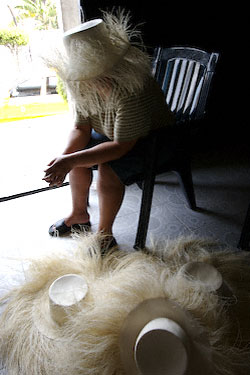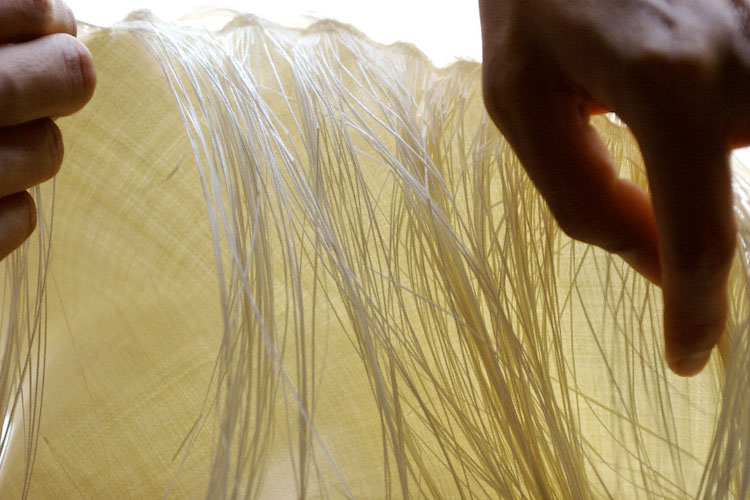
Edging Closer
9. The Azocador Tightens the Brim Edge
These hands belong to Victoria. She is the wife, now widow, of Rosendo Delgado. I have known her for more than thirty-five years. She has always been a special favorite of mine.
She is very smart. Very sly. More than anyone else, she goes along with my many jokes and pranks. She never hesitates to play a prank on me. Never hesitates to hurl insults in my direction. From Victoria, when we are playing, they are like Valentines. If I start up with some line of bull, Victoria will often go along with me and we will collaborate to spin some goofy yarn, just to see if we can persuade the other person to believe us. She was willing to be part of a five-person conga line in the streets of Montecristi. Sober.
Honestly—how many people do you ever know in a lifetime who would do that with you? Victoria is a much better dancer than I.


Here she is putting a funny hat on Fausto. I brought the hat. And a camera. What a coincidence.
Fausto was a cortador. He is 90-something in these photos. He looked much the same at 70-something. There are several photos of Fausto in the next section. Like Victoria, Fausto was also a better dancer than I. But I was gaining on Fausto after he passed 90. Victoria, not so much.


The azocadora receives the hat after the rematadora loosely weaves the back weave. Then the azocadora carefully pulls the back weave tight.
In the photo to the left, look by her left thumb. You can see where the edge is wider before she pulls, and narrower after she pulls. Like most things related to the hats, this is a lot harder than it looks.
Below right, Victoria clowns for the camera. She did that on her own. I did not suggest it.





This is Don Clemente. He was an âzocador. A good one. He worked on all my hats for several years.
On most of my hats, the back weave is tightened three times, three complete revolutions around the brim edge. Each time around, the back weave is tightened a little more. To tighten it all at once would cause the brim edge to pucker and distort.



Look how small that is.
This is slow, patient work.



Above, the azocador wets the back weave before he begins to tighten it. His experience tells him how long to leave the hat in the pan of water. If the straw is too wet, it becomes too soft and stretchy.



You can easily see that the hat he is working on in the photo above right and in all three photos below is a very finely woven hat. It is one of Simón’s. Look how it glows as the light shows through. It is a jewel. I have it here now. Wish you had it there? Get a home equity loan then give me a call.



The back weave of Simón’s hats, and other hats that are very, very fine, is tightened even more carefully and slowly. Each of these special hats requires five revolutions, five painstakingly slow turns around the outer brim edge, tediously tightening little by little.





Compare the two hats above. The hat above right, below center and left, is not as finely woven as Simón’s. Few hats are.




|
Next, the cortador trims the brims and other long straw. Next Page |

|
10. The Cortador Cuts Off the Excess Straw go to
Text and photos © 1988-2022, B. Brent Black. All rights reserved.
100% Secure Shopping









































